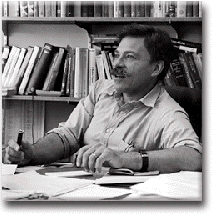Frontiers in Soft Condensed Matter Workshop
 A native of Brooklyn, Paul Chaikin attended Stuyvesant High School and then Caltech, where he received his bachelor’s degree in Physics in 1966. He then returned east to the Department of Physics and Astronomy at Penn, where he worked with Ted Mihalisin (at Temple) on superconductivity in metal alloys, which formed the basis for his 1971 Ph.D. thesis, “Probing Many Body Effects with Superconductivity”. But Paul also developed an interest in “soft” materials during his time as a graduate student, and stayed at Penn for an additional year as a postdoc in the LRSM, working with Alan Heeger and Anthony Garito on polarons in molecular crystals, such as TCNQ and its charge-transfer salts. Both of these projects were a mixture of theory and experiment (more experiment in the former, more theory in the latter)—a point worth noting for those of us who think of Paul purely as an experimentalist.
A native of Brooklyn, Paul Chaikin attended Stuyvesant High School and then Caltech, where he received his bachelor’s degree in Physics in 1966. He then returned east to the Department of Physics and Astronomy at Penn, where he worked with Ted Mihalisin (at Temple) on superconductivity in metal alloys, which formed the basis for his 1971 Ph.D. thesis, “Probing Many Body Effects with Superconductivity”. But Paul also developed an interest in “soft” materials during his time as a graduate student, and stayed at Penn for an additional year as a postdoc in the LRSM, working with Alan Heeger and Anthony Garito on polarons in molecular crystals, such as TCNQ and its charge-transfer salts. Both of these projects were a mixture of theory and experiment (more experiment in the former, more theory in the latter)—a point worth noting for those of us who think of Paul purely as an experimentalist.
In 1972, Paul returned to southern California, taking up a position at the Department of Physics at UCLA, where—as most of us do—he started a research program which built on his prior work, studying metal alloys and organic conductors. But Paul’s diverse research interests would quickly lead him into other areas. From small-molecule organic conductors, he moved into conducting polymers: first poly(sulfur nitride), (SN)x, then polyacetylene. In this phase of his career, Paul was conducting “hard” condensed matter measurements (quantum electronic physics, low temperature physics) on “soft” materials. But in 1982, Paul and graduate student Herbert Lindsay published a seminal paper on colloidal crystals and glasses—aqueous dispersions of charged polystyrene spheres —which marked his “true” entrance into the field for which he is now so well known.
After rising quickly rising through the ranks to Professor at UCLA, Paul returned to Penn and to the LRSM as Professor of Physics in 1983. That also marked the start of Paul’s formal association with Exxon Research and Engineering (first as Research Associate, then as Consultant), which continues to this day. At Penn, Paul continued his work on organic conductors and superconductors, as well as on the newly-discovered high-Tc superconductors, while with his Exxon colleagues, he expanded his work on the physics of colloids and other complex fluids.
 In 1988, Paul moved slightly further north along I-95, to become Professor of Physics at Princeton (and in 2001, Henry Dewolf Smyth Professor of Physics). At Exxon, he continued to investigate complex fluids and soft solids, and at Princeton, he continued his work on organic conductors and superconductors. He also started collaborations at Princeton with Bill Russel on colloids, which led to experiments on the space shuttle, and with Rick Register on block copolymer thin films for nanofabrication. Paul’s most recent research initiative, with Sal Torquato, has been the discovery that M&Ms (or, more scientifically, oblate ellipsoids) can form random packings to higher densities than spheres. (Princeton University Press Release and CNN.com)
In 1988, Paul moved slightly further north along I-95, to become Professor of Physics at Princeton (and in 2001, Henry Dewolf Smyth Professor of Physics). At Exxon, he continued to investigate complex fluids and soft solids, and at Princeton, he continued his work on organic conductors and superconductors. He also started collaborations at Princeton with Bill Russel on colloids, which led to experiments on the space shuttle, and with Rick Register on block copolymer thin films for nanofabrication. Paul’s most recent research initiative, with Sal Torquato, has been the discovery that M&Ms (or, more scientifically, oblate ellipsoids) can form random packings to higher densities than spheres. (Princeton University Press Release and CNN.com)
In 1995, the textbook Principles of Condensed Matter Physics—coauthored by Paul Chaikin and Tom Lubensky—was published by Cambridge University Press in hardcover, and in paperback in 2000, finally putting soft condensed matter physics on an educational par with its “hard” counterpart. Principles of Condensed Matter Physics has quickly become the definitive textbook for the structure and dynamics of soft condensed matter (and featured on British television!).
Among Paul’s major awards are a Sloan Fellowship (1979-81), a Guggenheim Fellowship (1997), and election to both the American Academy of Arts and Sciences (2003) and the National Academy of Sciences (2004). Paul is now in the process of moving yet a little further up the Northeast Corridor, to NYU, and doubtless into new research areas as well.